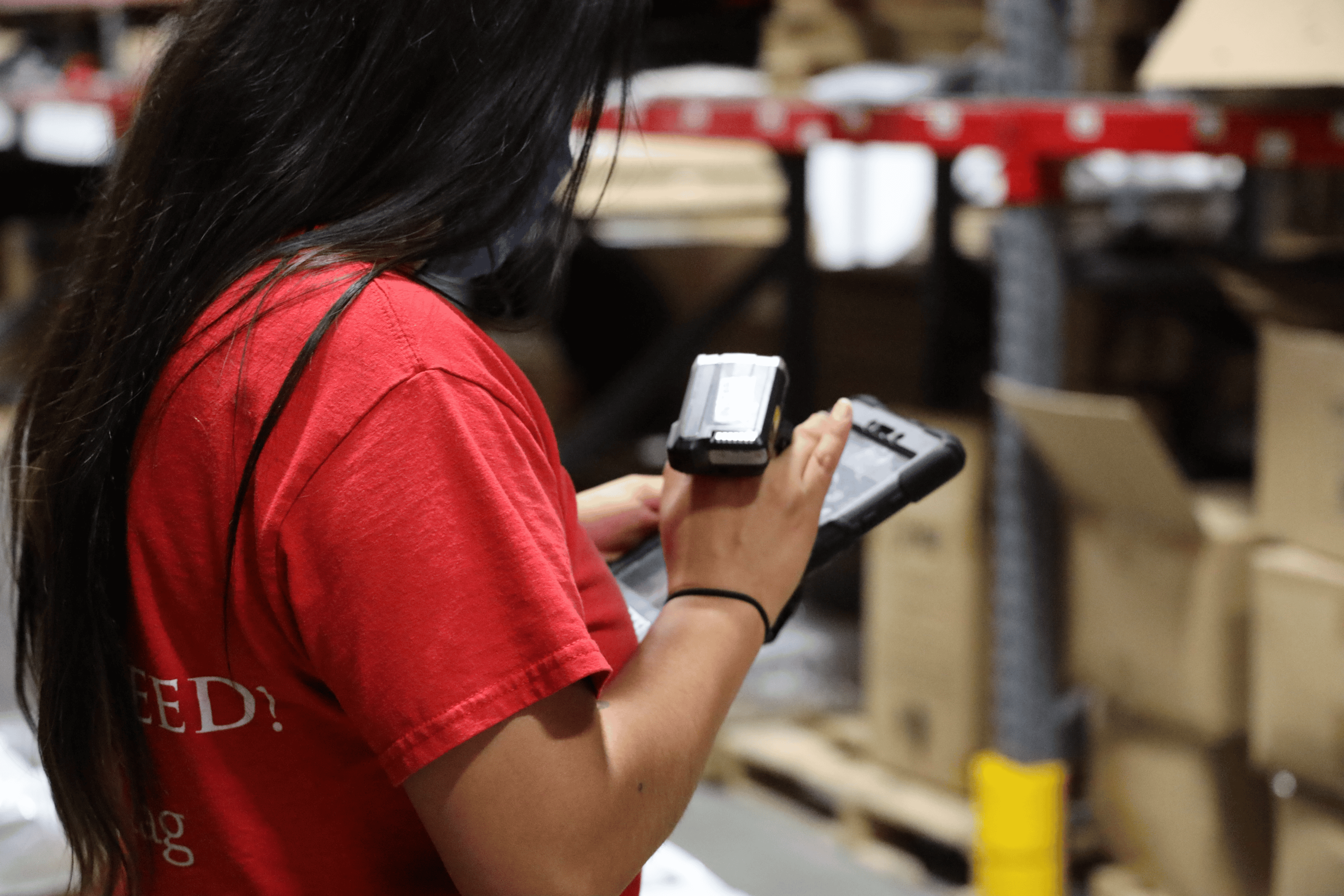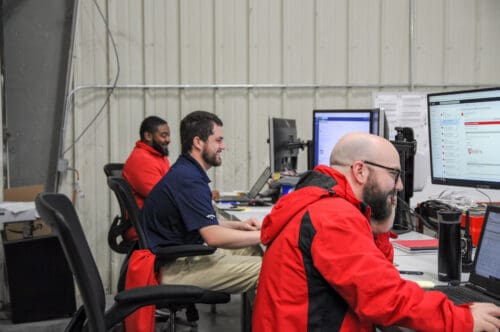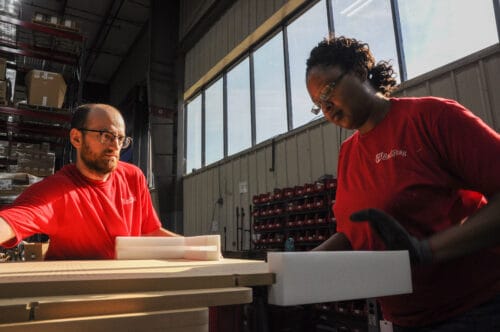The right Amazon 3PL provider could improve your shipment accuracy, cost efficiency, and growth opportunities. That’s because a 3PL, or third-party logistics provider, has reliable systems and information to fulfill orders quickly and some even meet Amazon’s standards for Seller Fulfilled Prime.
Amazon offers its own fulfillment services, but they may not be right for everyone. You just don’t get a lot of personalized attention or cost control from such a large company.

Editor’s note: You may have noticed we put ourselves (Red Stag) at the top of this list. That’s not because we’re the best fit for everyone. We’re actually quite selective—we only work with a small percentage of businesses who contact us.
Our specialty is providing Amazon alternatives through Seller Fulfilled Prime (SFP) for larger items (over 20 pounds), Fulfilled by Merchant (FBM) services, and FBA prep. We excel with companies shipping big, heavy, bulky products or smaller items with low SKU counts who want more control over their Amazon fulfillment.
However, even if we’re not a perfect fit, you should still reach out.
We’ll have an honest conversation about your Amazon business needs and challenges. If we’re the right partner—fantastic. If not, we’ll connect you with a 3PL better suited to your needs.
Schedule your free Amazon 3PL consultation today.
For more hands-on fulfillment help, you might benefit from partnering with one of these Amazon 3PL alternatives:
- Red Stag Fulfillment Best known for shipping heavy, bulky, or oversized items, with 100% accuracy guarantees and $50 compensation for errors. Capable of operating within Seller Fulfilled Prime.
- Fulfillment by Amazon (FBA) A comprehensive fulfillment service for Amazon sellers, offering warehousing, inventory management, shipping, and customer service. Limited in services offered and may contain lots of additional fees.
- ShipBob Ideal for businesses needing FBA preparation services, with 99.95% fulfillment accuracy rate for Amazon and non-Amazon orders, no SFP support.
- ShipMonk Best for Amazon sellers needing Seller Fulfilled Prime support, with 99.99% order accuracy rate and less than 2% inventory shrinkage.
- ShipNetwork Suitable for Amazon sellers requiring inventory management and order fulfillment, with 100% order accuracy guarantee.
- Shipfusion Ideal for Amazon sellers needing FBA prep services, with a 99.9% order accuracy rate across Amazon and non-Amazon orders.
If you are still just trying to wrap your head around all the fulfillment world, check out our guide on how to choose a 3PL.
Best Amazon 3PL companies
| Fulfillment costs | Accuracy | Networks | Support | |
|---|---|---|---|---|
| Amazon FBA | Per-unit pricing based on product size, weight, and shipping speed | Amazon doesn’t share FBA metrics | 200+ fulfillment centers, available in 10 countries | 24/7 support with seller login, knowledge base |
| Red Stag Fulfillment | Custom pricing, no hidden fees | 100% accuracy backed by guarantees, RSF pays $50 to customers for errors | 2 fulfillment centers, delivery to 96% of U.S. within 2 days, ships almost anywhere | Phone calls typically answered by people, email |
| ShipBob | Custom pricing | 99.95% fulfillment accuracy rate for Amazon and non-Amazon order fulfillment combined | Ships from its own warehouses to Amazon FBA warehouses, can arrange other shipping | Phone, email, in-platform chat |
| ShipMonk | Pricing tiers based on monthly order volume | 99.99% fulfillment accuracy rate, <2% damage rate | Ships from its own warehouses to Amazon FBA warehouses, can arrange other shipping | Phone, email, case submission on website, knowledge base |
| ShipNetwork | Custom pricing | 100% accuracy backed by guarantee | 11 fulfillment centers, ships almost anywhere | Phone, email, website case submission |
| Shipfusion | Custom pricing | 99.9% order accuracy rate, 99.9% on-time delivery rate | 4 fulfillment centers in U.S. and Canada | Website case submission, live chat |
There are many reasons to look outside Amazon for third-party logistics companies. Firstly, diversification is a common supply chain tactic. You might use a 3PL provider for extra order fulfillment during peak seasons or allocate certain products to fulfillment centers with specialized equipment.
But you may also need more than Amazon can offer. An independent 3PL provider can work closely with you to negotiate shipping costs or help you refine warehousing and inventory management strategies. Personalized relationships may provide you with a better customer experience.
There isn’t necessarily one best 3PL for Amazon sellers, but you can consider your ecommerce business’ needs to find the right one for you. We’ve compiled a few options for you to review.

1) Red Stag Fulfillment
We might be biased by placing ourselves so high on this list. But we also might be the right 3PL provider for you. See what you think.
Services
Red Stag Fulfillment provides extensive fulfillment services for ecommerce and retail businesses. If you choose us as your 3PL provider, you’ll benefit from more than Amazon order fulfillment.
Partner with us to maintain more control over warehouse costs, packaging materials, shipment costs, and customer satisfaction for your Amazon, Shopify and other e-commerce platforms.
Red Stag offers receiving, storage, and inventory management from warehouse locations in Knoxville, TN and Salt Lake City, UT. These locations sidestep the high prices and congestion risks of coastal and urban areas. With the right number of warehouses in the right locations, you can streamline how you manage inventory. Simplifying allocation makes it easier to meet customer demand and likely reduce carrying costs.
Our dedicated experts will always do their best to meet your exact fulfillment needs. That could include helping you coordinate transportation from ports or factories, using your custom packaging, handling promotional bundling, arranging same-day shipping, and other services.
We also provide specialized fulfillment for heavy or bulky items, which can require packaging expertise and strong carrier relationships to avoid excessive costs and damages. If you’ve struggled to find an Amazon 3PL that can handle oversized items, we might be the right partner for you.
From our warehouses, you can reach 96% of U.S. homes within two days with standard shipping. We also provide expedited shipping to areas outside our typical reach, so you can continuously meet the requirements of Amazon Seller Fulfilled Prime and attract new customers with a high-quality fulfillment process.
Accuracy
Red Stag Fulfillment offers accuracy guarantees you’re unlikely to find with other 3PL providers.
We guarantee 100% of your orders will be shipped on time or we’ll cover the cost of the shipment and give you an extra $50 for the inconvenience.
We also guarantee 100% order accuracy. If we ship the wrong item or wrong number of items, we’ll fix the mistake, pay the shipment cost, and give you $50.
Why do we pay you $50? Because fulfillment mistakes hurt your business. As your partner, we believe we should be accountable to you for the headache. This keeps our incentives aligned, so you can feel confident we have the same goals.
Pricing structure
Red Stag provides customers with full pricing transparency with no hidden fees so you can better manage your fulfillment costs. We design custom agreements based on your company’s specific details, like product types and order volumes. That way, pricing matches exactly what you need—nothing more, nothing less.
Our accuracy guarantees create even greater pricing predictability. You’re never on the hook for the cost of the rare mistake, although you might be with other 3PLs.
Customer support
Red Stag Fulfillment strives to provide excellent customer service in all matters. Our team of dedicated experts is proactive about helping you find ways to improve performance across all of your sales channels, not just Amazon.
Many members of our Client Success team began their careers at Red Stag working on the warehouse floor. Their deep understanding of fulfillment allows them to assist you with various challenges and opportunities, including cost optimization and growth.
Have questions? We reply quickly. In fact, we often have a live human answer our phones.
2) ShipBob
Services
ShipBob offers limited Amazon fulfillment services. The 3PL provider offers FBA preparation, packaging orders with FBA labels and shipping items to Amazon’s fulfillment centers. That means ShipBob can’t qualify its customers for the benefits of the Seller Fulfilled Prime program.
There are some caveats to the FBA prep service, too. It’s only available to customers who already meet a minimum order quantity on other sales channels.
Accuracy
The company claims a 99.95% order fulfillment accuracy rate across its Amazon and non-Amazon fulfillment services.. It doesn’t publish metrics for its FBA prep service.
Pricing structure
ShipBob customizes pricing based on services. For a business to qualify for its FBA prep services, it must meet a minimum order quantity with pricing based on storage, order processing, pick and pack, and shipping costs. Beyond that pricing, it may also provide additional pricing structures for Amazon FBA prep services.
Customer support
ShipBob provides 24/7 customer support by phone, chat, and email to address questions, issues, and exceptions. It also provides training and education resources, including documentation, videos, and webinars on its website.
3) ShipMonk
Services
ShipMonk provides order fulfillment services for Amazon sellers, including support for Seller Fulfilled Prime, which requires sellers or their 3PLs to pick, pack, and ship products for delivery within two days. It also provides FBA prep services.
Accuracy
ShipMonk claims a 99.99% order accuracy rate and less than 2% inventory shrinkage due to damages across its order fulfillment processes. It doesn’t publish packing and labeling accuracy metrics for its FBA prep services or on-time rates for its SFP shipments.
Pricing structure
The third-party logistics company provides customized quotes for Amazon seller services. Pricing for its non-Amazon fulfillment is by tiers determined by monthly order volumes, but the company doesn’t share Amazon-specific fulfillment pricing and fees.
Customer support
Customers can call, email, or submit cases on ShipMonk’s website.
4) ShipNetwork
Services
ShipNetwork can act as a third-party logistics solution for Amazon sellers, offering inventory management and order fulfillment services. But it doesn’t support Seller Fulfilled Prime or provide any other services that align with Amazon programs.
Accuracy
ShipNetwork guarantees 100% order accuracy and will fix any mistakes it makes. But it doesn’t compensate its customers for mistakes.
Pricing structure
Pricing is customized based on services. ShipNetwork claims it can help reduce shipping costs as part of its overall cost structure. But with more than 10 warehouses, prices may reflect ongoing inventory allocation across its network. Businesses may also have to increase order quantities with suppliers to have enough inventory for each fulfillment center.
Customer support
The 3PL offers U.S.-based customer support and is available by phone, email, and website form submission.
5) Shipfusion
Services
Shipfusion offers FBA prep services, which include packaging orders with FBA labels and shipping items to Amazon’s fulfillment centers. That means Amazon sellers have to work with another 3PL to join the Seller Fulfilled Prime program.
Accuracy
Shipfusion claims a 99.9% order accuracy rate across its Amazon and non-Amazon orders. It doesn’t share metrics for FBA prep services.
Pricing structure
The 3PL provider offers custom pricing based on services.
Customer support
Shipfusion customer support is limited to chat and case submissions on its website.
Amazon’s fulfillment services
Amazon offers fulfillment services and benefits to its sellers under Fulfillment by Amazon (FBA) and Seller Fulfilled Prime (SFP). Its Multi-Channel Fulfillment (MCF) offers third-party logistics solutions for non-Amazon sales channels.
Fulfillment by Amazon
Fulfillment by Amazon provides third-party logistics services, including warehousing, inventory management, pick and pack, shipping, customer service, and returns handling.
If a seller’s only objective is to outsource order fulfillment, FBA could be a good fit. Amazon has more than 1.5 million workers across two thousand fulfillment centers, so it can serve just about any ecommerce business. FBA doesn’t disclose order accuracy and on-time delivery rates, but Amazon as a whole has built its reputation on fast deliveries.
Sellers who need more than basic logistics services may want to look beyond FBA. For example, an independent 3PL provider can offer things Amazon can’t. This could include workflow and packaging customizations, extended inventory management, and other supply chain services, including growth support.
Multi-Channel Fulfillment
Amazon offers Multi-Channel Fulfillment (MCF) for sellers who manage other sales channels, such as their own website, other marketplaces, and social-media storefronts.
Technically, anyone can use MCF, even if they don’t sell on Amazon, but for Amazon sellers, the program can help unify all fulfillment within Amazon’s network.
Seller Fulfilled Prime
Seller Fulfilled Prime puts sellers in charge of order fulfillment, while providing marketing benefits on the platform, like the use of the Prime badge on individual products. The Prime badge signals to potential customers that they’ll receive fast, accurate deliveries.
SFP can help increase discoverability, too. When people see the Prime badge, they may be more likely to engage with a product listing, which could tell Amazon’s algorithm that those products satisfy customers.
But using the Prime badge also means meeting Amazon’s requirements. These include strict pre-qualification criteria, like low cancellation rates and high tracking accuracy. Seller must also commit to fulfilling orders with one-day and two-day delivery at no additional charge to Prime customers.
Ecommerce businesses that meet initial requirements participate in a 30-day trial to prove they have the right logistics operations in place. Even after the trial, businesses must continue to meet quality standards or risk being removed from the program.
It’s a challenging set of standards, and not every business is equipped to meet them on their own. This is where a third-party logistics company can help. A good 3PL provider has the processes in place to help you achieve enrollment in Seller Fulfilled Prime.
Work with Red Stag for your Amazon 3PL needs
With a solid 3PL Amazon partner, your business can focus on sales opportunities. An experienced fulfillment partner takes storage, picking, packing, and shipping off your plate.
At Red Stag, we provide full support as an Amazon third party logistics partner including support for Seller Fulfilled Prime and can efficiently fulfill orders as an alternative to Fulfillment by Amazon.
But you may have stronger outcomes with a 3PL that handles more than Amazon orders. That’s why the team at Red Stag offers end-to-end fulfillment solutions, including services like demand planning that can help with faster inventory turnover and maximized pricing on Amazon and other channels.
Want to streamline all your channels? We offer omnichannel fulfillment for businesses of all sizes.
Our expert team will work closely with you to learn about your supply chain. This information helps us tailor our strategies and pricing to your exact needs. Partner with us to discover ways to streamline fulfillment and improve profitability.
Reach out to see if we’re the right Amazon 3PL for your business.











